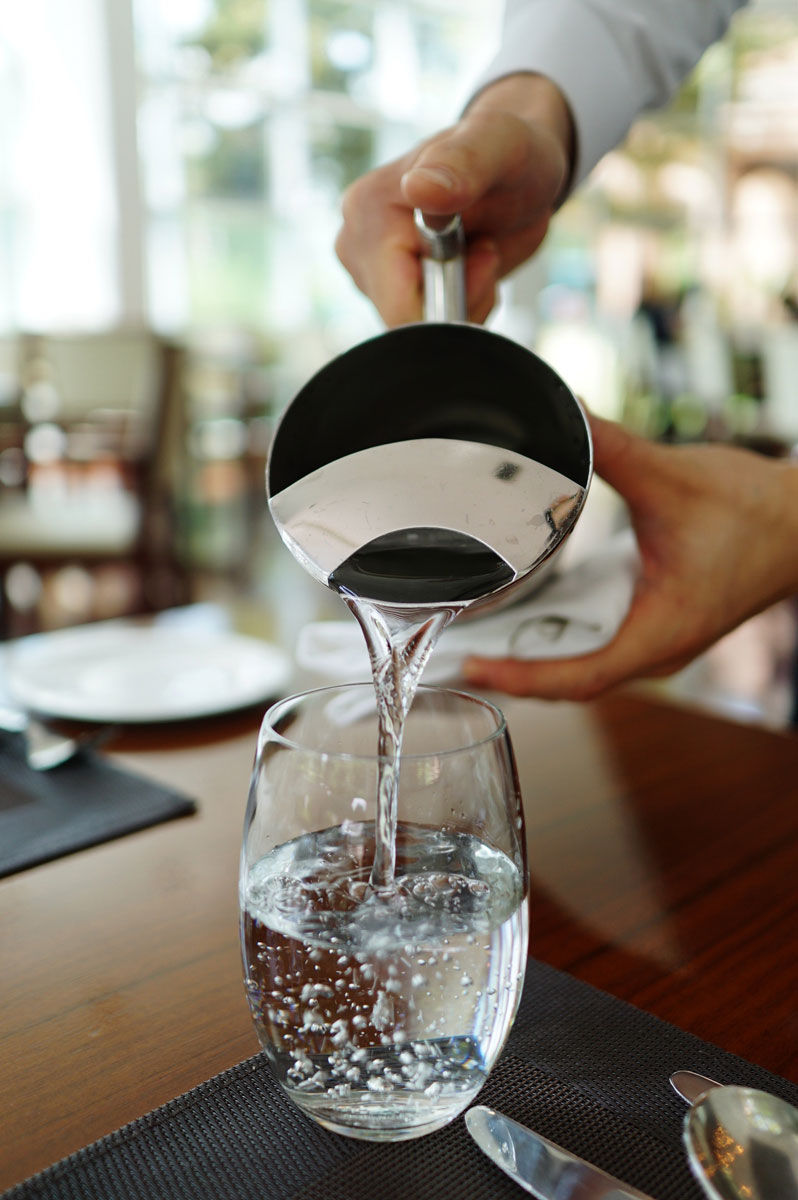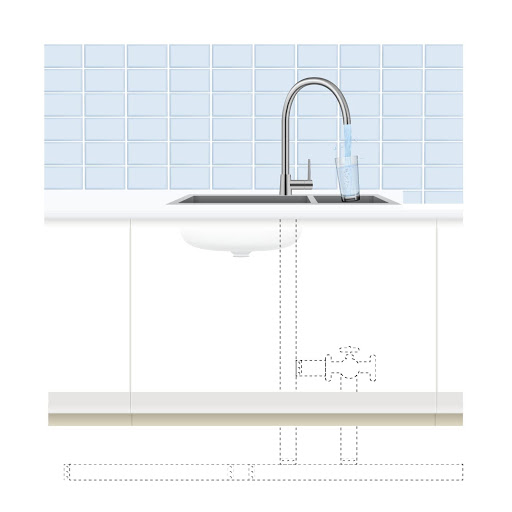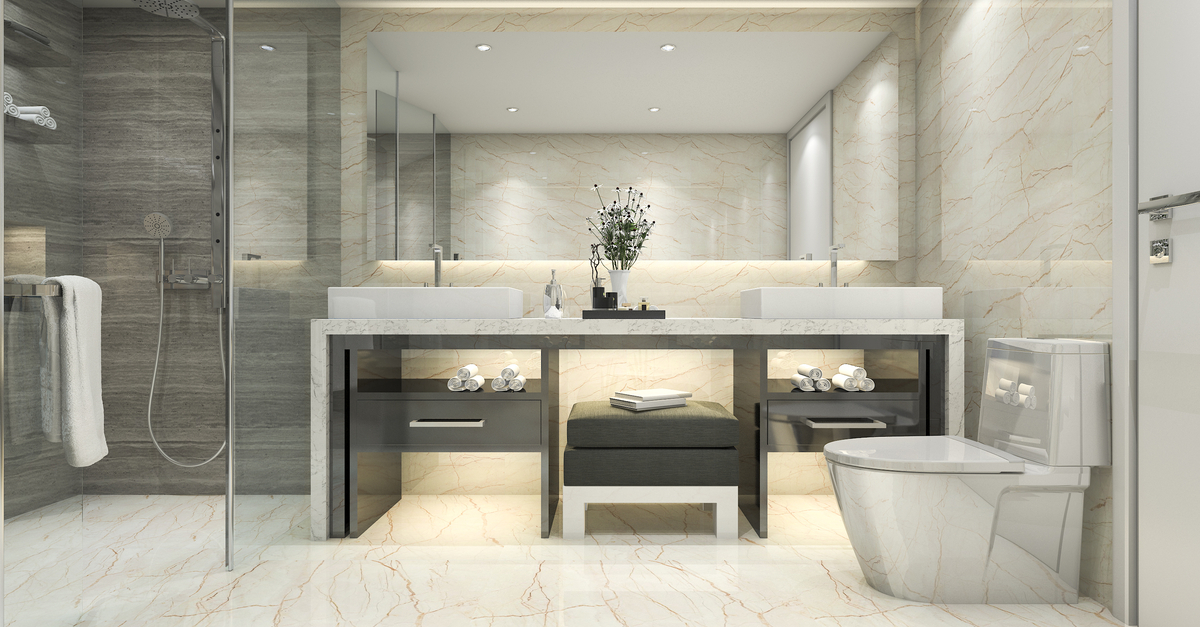Choose Your Location:
One of the fundamental needs of a healthy home is a clean, safe water supply. In fact, it's such a fundamental resource, it's easy to forget how much we rely on it. Each person requires a minimum of 20 to 50 litres of clean water a day to sustain a healthy life. Not only for hydration; clean, safe water is essential to sanitation and the prevention of illnesses.
It’s highly likely that you’ve started many days at home with the following routine; wake up, turn on the shower, wash, go to the kitchen, turn on the tap, clean and prepare food and move on, ready for the day ahead. But when we perform such basic household functions as running the cold tap, do we notice what's really there? Is your water supply as transparent as it looks?

Before your water reaches your shower or kitchen, it must first navigate a network of pipes in your home’s plumbing system. This system is essential to getting this precious resource into your home efficiently and safely. Common materials used in the construction of water distribution systems include high-density polyethylene (HDPE) or polyvinyl chloride (CPVC). These popular plastic alternatives to copper are appearing in more and more homes; but what difference does it make to taste? Water is expected to emerge into our home pure and neutral. however, this is rarely the case.
A study by Andrea Dietrich Ph.D, presented to the American Chemical Society found that water stored in several types of plastic piping produced low to moderate odours and flavours, such as “waxy plastic citrus” or “burning plastic.” Water from each pipe also underwent a chemical analysis for compounds that may have leached into the water from the pipe’s surface. The pipes used were CPVC, HPDE and two crosslinked polyethylenes, PEX-aA and PEX-b. All had varying degrees of odour and organic chemical leaching, which reduced gradually over time from frequent use, with CPVC ranked as the polymer least likely to produce an unusual foreign odour by imparting additional chemicals. Each pipe material is certified for use in potable water by NSF International.
If a minimum of 20 to 50 litres of water passes through your plumbing system at home, per person, per day, should this be of any concern? Does the migration of substances to our water have any effect on our bodies, or does it go unnoticed?
This migration of substances occurs in the water distribution system; it all takes place in the plumbing. The durable, long-lasting plastic piping that distributes water in most residences is all susceptible to some element of degradation and migration. It is important to know what’s taking place inside the system, to know the risks associated with the chemical reaction that begins as soon as the hot and cold tap is turned on at home. To know what’s happening inside our water, we need to know what’s going on inside the pipe

At the very beginning of your water’s life cycle, it undergoes various filtration and decontamination treatments at a water plant. This is where water sourced naturally becomes safe to use. However, on its journey through the plumbing system to the kitchen or bathroom, bacterial buildup can occur along the surface of the plastic pipe along the way. Microbial Water Contamination is made possible because of Biofilm.
Biofilm is formed over time on surfaces in wet environments, such as pipes used to transfer liquid. It adheres to the inner surface of the pipe, forming a slimy, glue-like substance where bacteria can form and grow. Gradually, biofilm becomes capable of releasing microorganisms and bacteria into the water. This release of bacteria can not only alter the quality of water, but it can also lead to a number of known illnesses.
Legionella is a waterborne disease that thrives in warm wet environments of 32° to 42°C, making plumbing systems the ideal location for growth. It can be transferred to the human body in mist form, such as the shower head. Infection can cause illnesses such as mild influenza or even pneumonia.
Water that has been contaminated by Pseudomonas can lead to lung infections and in some cases, severe infections of the blood. This is a particular risk to residents with weakened immune systems.
Coliform bacteria, of which E-coli is a member, is known to grow through biofilm in water and can lead to mild or extreme gastrointestinal illnesses. Coliform bacteria is a naturally occurring growth in the intestines of humans, however it can become a dangerous pathogen if found in water.
While it’s easy to assume the pipe’s surface is as smooth on the inside as the outside and therefore incapable of accommodating unwelcome microbial residents, there are chemical reactions at work which are altering the pipe’s surface, allowing bacteria to adhere more easily, encouraging biofilm to build a home within your home. To understand the source of this process, we return to the water treatment plant.
To eliminate naturally occurring bacterial presences in water sourced from the reservoir, treatment plants utilize chlorine and chlorine dioxide to kill the bacteria and make water safe to be distributed to homes. The addition of chlorine to the water produces hypochlorous acid, which can have a corrosive effect on many internal pipe surfaces. This creates small gouges along the surface of the pipe, developing a suitable platform for microbial growth.
Pipe smoothness is therefore essential to long-term biofilm prevention. However, the presence of chlorine in treated water is inevitable, necessary and not without its effects on the internal structure of your plumbing at home. So how can we prevent the threat of biofilm in the family home, without building a treatment plant on every driveway? The answer is in the pipes’ biofilm resistance.
With a clearer picture of what enters your home when you turn on the cold tap for your first drink in the morning, you can now understand that homeowners need one last line of defence in the prevention of corrosion, biofilm buildup and microbial contamination. The solution doesn’t require chemicals, additives or apparatus; it’s in the plumbing system itself.
The long term benefits of a clean, safe water supply require long term resistance to chlorine corrosion and biofilm formation. The smoothest pipe, made from the most resistant materials, installed in the most efficient way. What does this material look like?
In an assessment conducted by Kiwa Water Research, microbial growth potential was tested on multiple materials which are built to accommodate water intended for human consumption. These materials are used today in plumbing systems in homes around the world. They include Polypropylene, known as green pipe (PPR), chlorinated polyvinyl chloride (CPVC), stainless steel and copper. These materials were in contact with clean water and the buildup of biofilm on the surface of each pipe was monitored and assessed. The development of Legionella bacteria in the water was also tested, and there was one clear winner.
For biofilm resistance and Legionella contamination, non-metallic CPVC consistently outperformed other non-metallic materials, and in Legionella’s case, outperformed all of its rivals. Polypropylene (PPR) consistently displayed the greatest potential for biofilm formation compared to all other piping materials. It also scored highest for the number of Legionella bacteria flowing through the water.
So why is CPVC consistently the most resilient, efficient material for getting clean, safe water through your home to your family? Is it even something that’s easily accessible to families as a plumbing system solution?

CPVC is proven to be one of the safest non-metallic materials for your home water supply; for now and for the long term. To understand why, we need to go inside the pipe for a look at that smooth surface; how come CPVC is so good at evicting those irritating tenants from your home, despite having those all important wet surfaces running all the way through it?
FlowGuard CPVC pipe and fittings take smoothness seriously. Any disruption to the flat interior surface of a pipe, and bacteria has an open invitation into your home, to generate a layer of biofilm that will only get bigger. FlowGuard CPVC pipe surface stays smooth due to its superior corrosion resistance. Chlorine and chlorine dioxide transmitted through your water supply stands little chance against CPVC’s high-density material; all your water can do is flow right through to your home.
However, chlorine does have a positive effect on FlowGuard CPVC pipe and fittings; in fact, the pipe’s walls contain chlorine, and for good reason. The chlorine content in CPVC prevents unwanted pollutants in your home from permeating the outer walls of the pipe and passing through to the water supply within. Thanks to the chemical constitution of CPVC, your home has a strong line of defense against any chance of your home polluting its own water supply. Safe delivery of water, from the inside and outside of the pipe makes for better quality water and a safer home.
But what about the spaces in between? Throughout your home you have joints, fixtures and fittings holding everything together. So what about the sections of CPVC that aren’t solid and smooth, such as a join or a bend? The answer is cohesion.
An entire plumbing system made out of FlowGuard CPVC pipe and fittings becomes one single pipe, thanks to Solvent Cement Welding. This is not a solvent like the PVA in your children’s school bag or the nail glue in the bathroom, or even the super glue in your garage. This specialized solvent cement fuses CPVC pipes together at the molecular level, forming an unbreakable cohesive bond, transforming two pipes to one. In fact, this bond becomes the strongest part of your home plumbing system. Strong, long lasting connections for lasting resistance to biofilm and bacterial development. This also accommodates smooth flow of water towards the end of its journey in your bathroom or kitchen, with nothing harmful collected along the way.
Let’s return to those interesting flavours of “waxy citrus” and “burning plastic,” as discovered by research presented to the American Research Society. One might assume that a resilient chemical composition such as FlowGuard CPVC pipe and fittings, with a smooth efficient flow of water through the home should minimise the subsequent odour and flavour in your water. Fortunately, further research conducted by professor Andrea Dietrich at Virginia Tech demonstrates how CPVC is keeping pure water pure.
Professor Dietrich’s investigation into “water aesthetics” included a panel of human “testers,” to record their experiences in smell and taste after consuming water which had been stored in a number of different plastic and metallic pipe materials. All pipe materials can be considered as food packaging, which is essentially what our internal plumbing system is. A substance we consume every day is delivered in these vessels, and the results are very different to that of a typical food container.
The results showed that CPVC ranked as the polymer least likely to produce an unusual foreign odor by imparting additional chemicals and bacteria into the mix. Of course all substances affect taste, as do all forms of packaging, therefore an aftertaste of plastic was detected at first. However, the taste disappeared after continuous usage for several months. Good news for those of us that rely on a water supply on a daily basis.
When it comes to preparing food, it’s clear that our best chance of tasting only what nature intended is getting that water into our taps via CPVC. Its chemical composition, biofilm resistance and that all important smoothness is equipped for the safe delivery of life-giving water.
The question that remains is longevity. While the plastic odour, that “new pipe” flavour might fade completely after a short time, we are fully aware that natural forces are always going to be at work to taint our water supplies in the years to come. You can’t stop hydrochloric acid from doing its job. You can’t prevent environmental changes as home life evolves. And as much as many of us would like, you most certainly can’t change the weather. So will a fully installed network of residential plumbing made from FlowGuard CPVC pipe and fittings keep a family in clean living for months, years or generations?
CPVC experts FlowGuard have experience testing the longevity of CPVC plumbing. In fact, piping systems installed more than 55 years ago are still performing, and performing well.
FlowGuard also examined the long term effects of chlorinated water flowing across the surface of the pipe’s material. After 23 years, there was no sign of damage to the material, or reduction in size to the pipe surface diameter. By comparison, after just nine and a half months of testing, PPR pipe showed significant damage to the internal diameter.
In the same way we have observed chlorine resistance in a number of independent tests, FlowGuard CPVC pipe and fittings has that same chlorine resistance that keeps your water safe for longer. There are significantly less processes happening inside the pipe that will compromise your clean living experience at home. So it’s good news on the inside; what about the outside?
External factors such as light and temperature will always be present in the home, therefore changing conditions are inevitable. FlowGuard CPVC pipes are equipped to survive some of the most extreme changes in light and temperature in the home. It’s self-extinguishing, which means it won’t sustain a flame if exposed to a house fire. In external installations, Its resistance to prolonged UV exposure also keeps your water supply going strong through those long, hot summers. This is particularly why FlowGuard CPVC is the leading piping brand, chosen by more homeowners and plumbers throughout Saudi Arabia.
The popularity of CPVC has extended from homes in Saudi Arabia to some of the country’s most prestigious structures, including the SANG hospital chain. Five specialist hospitals across Saudi Arabia selected FlowGuard to deliver CPVC plumbing systems to their premises. A highly sensitive project due to obvious health and safety considerations. It was because of this high level of risk that FlowGuard CPVC was chosen; for its resistance to bacterial growth. The efficiency of installing FlowGuard CPVC pipes and fittings also meant that the process was much quicker and cost effective, without the need for hazardous tools. FlowGuard CPVC is trusted by local health services, to provide safe clean water to patients. The same material is doing the same job in homes around the world.
Among FlowGuard’s prestigious builds in Saudi Arabia is Riyadh University for Women. The building’s unique design included research laboratories and a 600-bed hospital, among the many other colleges, facilities and accommodation that make up the iconic complex. CPVC’s ease of installation makes it readily adaptable to provide safe, clean water to 60,000 students. Both residential and commercial properties dedicated to supporting young people are experiencing the benefits of FlowGuard CPVC every day.
A quick shower, or preparing and washing food for your family, should be simple and safe. But for it to remain that way, you need to trust that the substance you are using is safe for consumption, coming from a safe place, delivered in a safe way. 20 to 50 litres of clean water a day is not a luxury; it’s a basic human need. The science behind FlowGuard CPVC and its subsequent 60 years of global success isn’t there to remind you about biofilm formation, chlorine resistance and microbial migration; plumbers and homeowners are choosing FlowGuard CPVC so we can do what we’ve always done. Turn on the tap and enjoy clean living.

